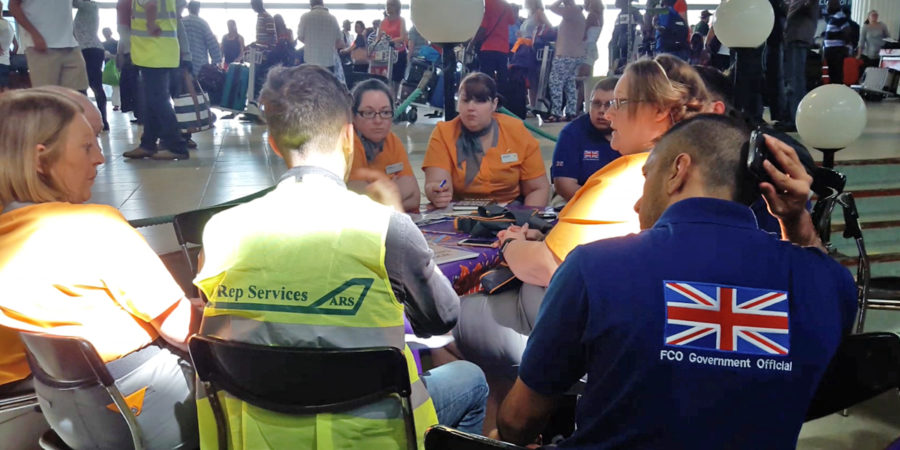The Foreign and Commonwealth Office is always front and centre of the UK government’s response to an overseas crisis. They’re always high pressure events and lives are often on the line. Depending on the scale there’s a whole set of processes and teams that swing into action, all centred around our Crisis Management Department (CMD), a crack team hidden in the basement of our headquarters in King Charles Street. Rapid Deployment Teams (RDT) of Foreign Office volunteers are often on the first flights to the country in question to boost numbers on the ground, emergency telephone helplines are fired up and experts in security, regional politics and media converge to coordinate with our nearest embassy and other government departments.
From the moment those first breaking news tweets start to appear on our dashboards, social media has a huge role to play in our crisis response. I’m going to share below a few of the actions and results from our use of social in responding to the recent political crisis in The Gambia. For background, the long-term President had just lost an election but was refusing to transition power to his successor. You may remember the headlines of the ‘former Argos security guard who becomes President’. For a period it looked like there was going to be a military intervention in a country with over 4,000 British residents and a further 1,500 visiting each week.
What channels do we have?
Using Hootsuite, our social media management tool of choice, we assign admin rights for our CMD team to all local channels. With over 1,000 official social media accounts and over 100 ambassadors using social it’d be very rare that we didn’t have an embassy with some sort of digital footprint. This helps CMD to publish critical information such as helpline numbers or changing travel advice should those on the ground be without access or simply too busy. It also allows CMD to monitor mentions and engagement with the account, particularly for British nationals in need of help. During the crisis in Gambia I was able to get vital information via Twitter from a family member in the UK whose young nephew had just flown to Banjul on his own and they’d lost contact with him at his hotel. The team at the airport was able to confirm they’d spoken to him at the airport.
Monitor
Using Hootsuite and other monitoring tools we set up searches using common themes and trending topics to scan the airwaves for useful information that can help inform understanding, identifying key accounts and sources of information or locate people in distress. Reports from these are now embedded into full crisis situation reports, or sitreps.
Publicise information
Often this might actually be the first action but it really depends how quickly we can be certain of facts on the ground. We have to be absolutely sure we’re providing the right advice. Dedicated accounts such as our Consular travel advice Twitter and Facebook always publish immediate responses. We used the main accounts to amplify critical information such as telephone numbers or instructions to follow using basic but clear infographics and links to our running gov.uk travel advice website for that country. This site went front page on both our main and embassy website and tracking visits to it over time helped to paint a picture of level of interest and desire for information.
Demonstrate grip
In times of crisis, fear and concern runs high. People need to be assured the government is working hard to help those affected and our actions have to be clearly explained. A cancelled trip is always going to cause stress. At first we started with quick pictures of the RDT team at the airport who were working with travel operators to organise flights home. I then worked with our ambassador and his deputy in Gambia to record a short video clip explaining the situation and response so far and capture some short GV footage to help bring this to life. I also recorded a similar version using our new “gimble” on the view from our London Crisis Centre with our Minister for Africa. The videos worked particularly well on Facebook and went a long way to explaining the situation.
Deliver the good news
Thankfully the Gambia political situation ended peacefully. It doesn’t happen often but on this occasion we had an opportunity to quickly reengage the audience who’d be following our feeds with some good news on the re-opening of flights. Again, our man in Gambia recorded another short clip to confirm this as well as the UK’s support for the new President and the Gambian people.
The results
Obviously the main successful outcomes would be the 18 emergency flights and 2,500 British nationals flown safely home. A peaceful Gambia high up there too. In terms of social media though the videos were particularly successful. In less than two minutes of footage the three clips were seen by almost half a million accounts with a total viewing time on Facebook alone of over a month. Qualitatively the response was overwhelmingly positive from both British travellers and Gambians. Even better, the two ambassador clips were recorded and transferred back to London by his deputy on our new work smartphones. Something that would be impossible on the ol’ Blackberry. The videos are now being embedded into our crisis simulator as examples of what an embassy response could look like.
You can see the 3 videos via the following links:
https://www.facebook.com/foreignoffice/videos/10154728508300630/
https://www.facebook.com/foreignoffice/videos/10154715789025630/
https://www.facebook.com/foreignoffice/videos/10154710149460630/

